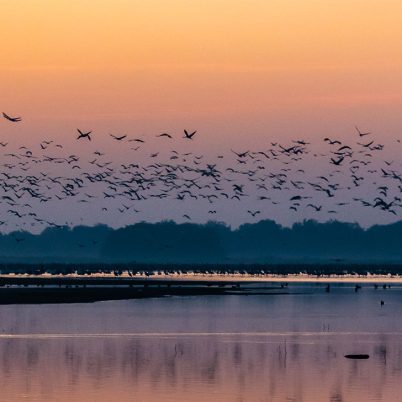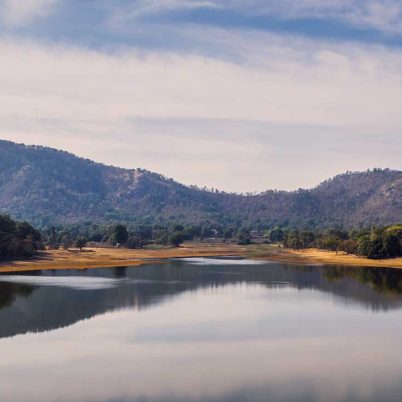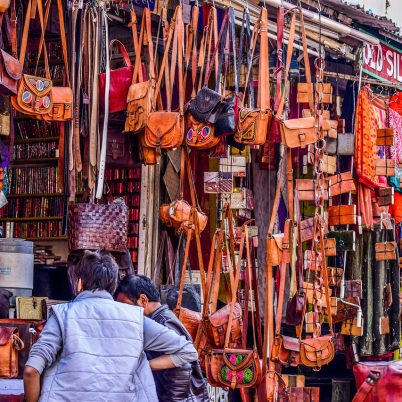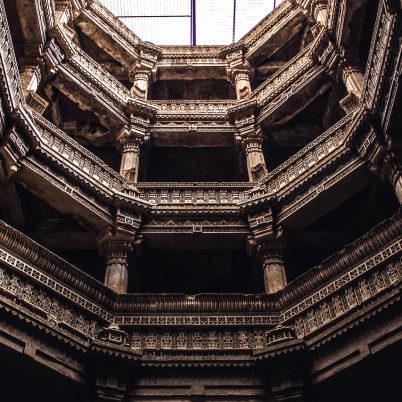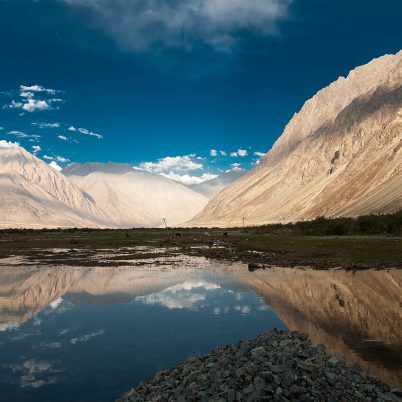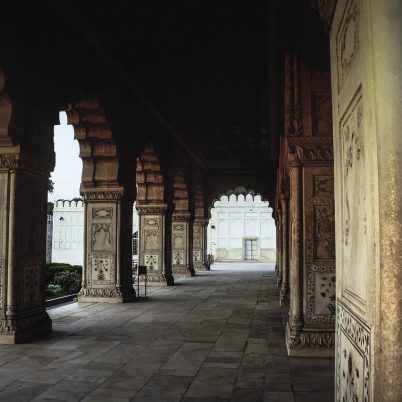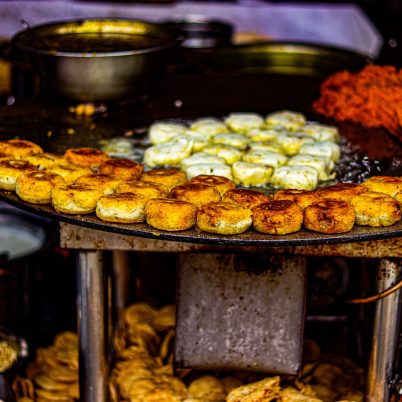There are many examples of Mughal architecture in India, as the Mughals reigned in India for around three centuries. Mughal architecture in India flourished during the reign of the Mughal empire from 1526 to 1857. A blend of Indo-Islamic-Persian styles of architecture, the new style found a place in various renowned monuments all over India. Here are some of the most famous examples of Mughal architecture in India.
Taj Mahal, Uttar Pradesh
Timings: Day visit – 6:00 a.m. to 7:00 p.m. every day except Friday
Night visit – 8:30 p.m. to 12:30 p.m. during full moon, plus two days before the full moon and two days after.
Taj Mahal is the epitome of Mughal architecture not just in India, but across the world. Perhaps the most prominent monument that comes to mind when you think of Mughal architecture, the mausoleum was commissioned by Mughal Emperor Shah Jahan in 1632 for his beloved wife, Mumtaz Mahal.
The Taj Mahal is celebrated as a symbol of love and an architectural marvel. The pristine monument, made entirely out of white marble and semi-precious and precious stones, was built by 20,000 workers over 22 years. The most outstanding features of the monument are the Arabic calligraphy, pietra dura, and the perfect symmetry.
The central dome rises 240 feet up in the sky and is surrounded by four minarets on two sides. Lush gardens cover the ground in front of the monument, with long watercourses and fountains.
If you thought nothing could compare to the beauty of the Taj Mahal in broad daylight, try seeing the monument on a full moon night. Yes, you can visit the Taj Mahal for five days of the month around the full moon.
Keep in mind that the Taj Mahal is closed on Fridays for prayers.
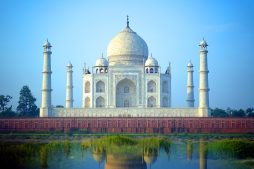 Taj Mahal, Agra
Taj Mahal, Agra
Red Fort, Delhi
Timings: 9:30 a.m. to 4:30 p.m. every day except Monday
As the name suggests, the Red Fort is built of red sandstone, and is a stunning example of Mughal architecture in India. Red Fort was built in 1648 as the fort capital of Shah Jahan, and was once the main residence of Mughal emperors for around 200 years. Even today, it is an important location – it is here that the Prime Minister of India unfurls the national flag every year on Independence Day.
It comprises palaces, vast halls, gardens, baths, and even a mosque inside the surrounding red walls that rise 75 feet up in the air.
A UNESCO World Heritage Site, the monument spreads across 256 acres and showcases the rich legacy of India. The Diwan-i-Aam and Diwan-i-Khas are two legendary halls in the Red Fort. Two other highlights in the fort include the gorgeous Moti Masjid and Rang Mahal.
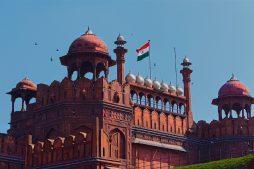 Red Fort, Delhi
Red Fort, Delhi
Humayun’s Tomb, Delhi
Timings: 6:00 a.m. to 6:00 p.m.
The first Mughal monument to be commissioned in India, Humayun’s Tomb was commissioned by Humayun’s widow, Bega Begum. The marvelous architectural style of this monument became the benchmark for Mughal architecture. The use of red sandstone and intricate embellishments of white marble in harmony exude elegance. The garden has a Persion Char Bagh layout which divides the garden into smaller segments. The complex includes many iconic buildings, tombs, and mosques, such as Arab Sarai, Nila Gumbad, and Bu Halima.
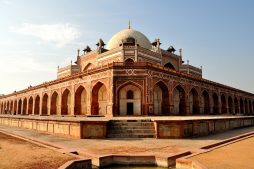 Humayun’s Tomb, Delhi
Humayun’s Tomb, Delhi
Bibi Ka Maqbara, Maharashtra
Timings: 8:00 a.m. to 8:00 p.m.
Bibi Ka Maqbara, meaning “Tomb of the Lady”, was commissioned in 1678 by Mughal Prince Azam Shah in memory of his mother, Dilras Banu Begum, posthumously known as Begum Rabia Durani. The monument, located in Aurangabad, draws a lot of influence from the Taj Mahal, which is why the monument is also known as Taj of the Deccan.
The monument boasts beautiful arches, intricate lattice work, floral and foliage designs, and rich interiors. Just like the Taj Mahal, Bibi ka Makbara has four minarets on all sides.
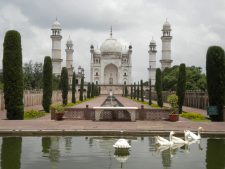 Bibi Ka Maqbara, Aurangabad
Bibi Ka Maqbara, Aurangabad
Shalimar Gardens, Jammu and Kashmir
Timings: 9:00 a.m. to 7:00 p.m.
Shalimar Bagh, or Shalimar Gardens, was built by Emperor Jehangir for his wife Nur Jahan in 1619. Situated on the right banks of Dal Lake, the garden is also known as Faiz Baksh and Farah Baksh. Mughal horticulture shines in this garden as you will see the beautifully manicured lawns filled with various blooming flowers.
The garden has four terraces, numerous fountains, trees, and a wide variety of flowers that bloom in spring and autumn. The garden is connected to the north-east of Dal Lake through a channel. Black marble is used in several places in the garden. A light and sound show is organized daily during the peak tourist season, from May to October.
 Shalimar Gardens, Srinagar
Shalimar Gardens, Srinagar
Pari Mahal, Jammu and Kashmir
Timings: 9:30 a.m. to 7:30 p.m. every day except Friday
Situated on the Zabarwan Mountain Range in Srinagar, the Pari Mahal, meaning “Palace of Fairies”, was once the residence of Dara Shikhoh, the son of Shah Jahan. It was later converted into an observatory for astronomy and astrology. Today, it is an important tourist attraction.
With seven terraced gardens filled with vibrant flowers and exotic fruits, the monument offers a delightful experience to nature lovers. The arched doorways and delicate water features make Pari Mahal a quaint tourist attraction. The location of the palace showcases phenomenal views of Dal Lake in the distance.
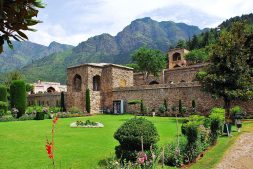 Pari Mahal, Srinagar
Pari Mahal, Srinagar
Agra Fort, Uttar Pradesh
Timings: 6:00 a.m. to 6:00 p.m.
The Agra Fort, also known as Fort Rouge, Agra’s Red Fort, or Qila-i-Akbari, was built by Emperor Akbar and later developed by his successors. With panoramic views of the Taj Mahal, the majestic fort was a military base for the Mughal Emperor Akbar. His son Jehangir later converted it into a royal residence.
The fort walls are made out of red sandstone, while the courtyards are adorned with pietra dura inlays. The Jahangir Mahal, Sheesh Mahal, and the Khas Mahal are a part of the Agra Fort.
Shah Jahan was imprisoned in Agra Fort by his son for the last years of his life. Historians believe he was kept in a room with views of Taj Mahal, the monument built by him.
 Agra Fort, Agra
Agra Fort, Agra
Akbar’s Tomb, Uttar Pradesh
Timings: 6:00 a.m. to 6:00 p.m. every day except Friday
The resting place of the famous Mughal Emperor Akbar, Akbar’s Tomb in Sikandra has a unique architectural style – it is a blend of Hindu, Islamic, Christian, Jain, Buddhist, and Persian influences, reflecting Akbar’s inclusive approach to religion and governance.
Originally commissioned by Akbar, the monument was completed by his son Jehangir. Use of sandstone and marble, geometric patterns and inlay work define the elegant monument. The structure has three-storeyed minarets. Furthermore, the five-storeyed tomb building is also home to the daughters of Emperor Akbar, Shakrul Nisha Begum and Aram Bano.
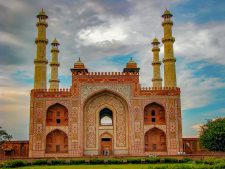 Akbar’s Tomb, Sikandra
Akbar’s Tomb, Sikandra
Fatehpur Sikri, Uttar Pradesh
Timings: 6:00 a.m. to 7:30 p.m.
The grand Mughal city of Fatehpur Sikri is just an hour’s drive away from the Taj Mahal. After visiting Sikri, Mughal Emperor Akbar found it auspicious, and constructed the city of Fatehpur Sikri in 1569 and made it the capital of the Mughal Empire.
Within two weeks, the city was abandoned due to a shortage of water supply, but even today, it is breathtaking in its beauty and architecture.
The Buland Darwaza, or the Door of Victory, is a 54 meter high gateway to Fatehpur Sikri. Built of red and buff sandstone, the Buland Darwaza is considered the highest gate in the world.
The expansive courtyards, sculptures, and architecture are a mix of Islamic and Hindu design styles. Some of the iconic monuments in Fatehpur Sikri include Panch Mahal, Palace of Jodha Bai, Jama Masjid, Tomb of Salim Chisti, Birbal’s House, and more.
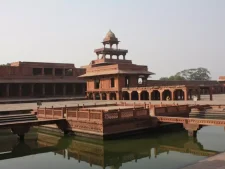 Fatehpur Sikri, Uttar Pradesh
Fatehpur Sikri, Uttar Pradesh
Jama Masjid, Delhi
Timings: 7:00 a.m. to 12:00 p.m. and 1:30 p.m. to 6:30 p.m.
The Jama Masjid, also known as Masjid-e-Jehan Numa, is another example of marvelous Mughal architecture in India. Built by Shah Jahan, Jama Masjid was the imperial mosque during the Mughal era.
Resting on a 10 meter high plinth of red sandstone, you have to walk some stairs to reach the mosque. The huge courtyard is built with red sandstone, with a capacity of 25,000 worshippers during namaz (prayer).
The monument has three massive domes surrounded by four towers and two minarets with a height of 40 meters. You can climb 130 steps up the minaret to viewing galleries with views of Chandni Chowk, a popular street in Delhi. Inlays and carvings on every surface add to the grandeur of the monument.
The Jama Masjid faces west towards the holy city of Mecca. It is a renowned tourist attraction and an important place of worship for Muslims.
 Jama Masjid, Delhi
Jama Masjid, Delhi
Itmad-ud-Daulah, Uttar Pradesh
Timings: 6:00 a.m. to 6:00 p.m.
Known as Baby Taj, the tomb of Itmad-ud-Daulah was built for Mirza Ghiyas Beg, commissioned by Jehangir’s wife Nur Jahan, in 1628. Very similar to the Taj Mahal, Itmad-ud-Daulah is more detailed in its artwork with intricate carvings, marble lattice screens, geometric patterns, and floral motifs. The dome of the monument is influenced by Persian style of architecture.
The monument is enhanced further by the stone inlay and the Persian garden, Char Bagh, adorned with water streams.
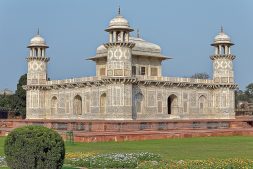 Itmad-ud-Daulah, Agra
Itmad-ud-Daulah, Agra
Taj-ul-Masjid, Madhya Pradesh
Timings: 6:00 a.m. to 8:00 p.m. Open on Fridays only for Muslims
The Taj-ul-Masjid is the largest mosque in India, and one of the largest in Asia. Built over a period of 57 years from 1844, the mosque spreads over 250,000 square feet. Taj-ul-Masjid translates to “Crown among Mosques”. The mighty mosque was founded by Sultan Shah Jahan Begum, the wife of Mughal Emperor Bahadur Shah Zafar.
Taj-ul-Masjid is located by the lake Motia Talab. Constructed out of red sandstone, the mosque has three domes and two minarets. It is even used as an Islamic school during the day.
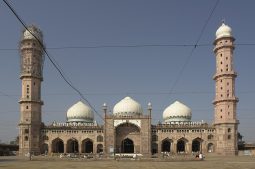 Taj-ul-Masjid, Bhopal
Taj-ul-Masjid, Bhopal
Mughal architecture has a rich legacy in India. Even today, they are the main tourist attractions in many parts of India. An important part of India’s history, these architectural marvels are conserved by the Archaeological Survey of India. Did these architectural structures fascinate you? Contact us and we can plan the perfect trip for you based on your preferences!
helping you travel your way
Everything you need to know about India is here We have tried writing about everything you may need help with for your trip to India, If you need help in planning a trip to India Get in touch with us to to plan your trip of a life time.


